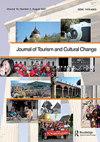Different cultures, different images: a comparison between historic conservation area destination image choices of Chinese and Western tourists
IF 2.5
4区 管理学
Q2 HOSPITALITY, LEISURE, SPORT & TOURISM
引用次数: 6
Abstract
ABSTRACT Using three Hangzhou Grand Canal historic conservation areas as the gaze fields, this study delineates differences in the image choices of visitors from cross-cultural backgrounds. Analysis of tourist-generated content, including destination image (DI) dimensions and frequency, suggests that Chinese tourists prefer human attractions and experiencing neighborhood life, while Western tourists prefer natural scenery and participating in tourist activities. The research also spotlights the phenomenon of the ‘tourist gaze circulatory.’ Tourists’ differentiated pursuits and on-site tourism experiences can influence the projection of DI, and the altered DI will in turn affect subsequent tourists. Based on this notion, suggestions are made for the in-depth development of the Canal’s historic conservation areas, differentiated for the different gazes of Chinese and Western tourists; and for a guide to help Western tourists experience Chinese urban life and enrich their gaze objects, with a view to protecting and enhancing world cultural heritage.不同文化,不同形象:中西方游客对历史保护区目的地形象选择的比较
摘要本研究以杭州大运河三个历史保护区为凝视场,探讨不同文化背景下游客在意象选择上的差异。对游客生成内容(包括目的地图像(DI)维度和频率)的分析表明,中国游客更喜欢人文景点和体验邻里生活,而西方游客更喜欢自然景观和参与旅游活动。该研究还强调了“游客目光循环”现象。游客的差异化追求和现场旅游体验会影响DI的投射,而改变后的DI又会影响后续游客。在此基础上,针对中西游客的不同视角,对运河历史保护区的深度开发提出了建议;帮助西方游客体验中国的城市生活,丰富他们的目光对象,以保护和加强世界文化遗产。
本文章由计算机程序翻译,如有差异,请以英文原文为准。
求助全文
约1分钟内获得全文
求助全文
来源期刊

Journal of Tourism and Cultural Change
HOSPITALITY, LEISURE, SPORT & TOURISM-
CiteScore
5.10
自引率
9.10%
发文量
31
期刊介绍:
Journal of Tourism and Cultural Change ( JTCC ) is a peer-reviewed, transdisciplinary and transnational journal. It focuses on critically examining the relationships, tensions, representations, conflicts and possibilities that exist between tourism/travel and culture/cultures in an increasingly complex global context. JTCC provides a forum for debate against the backdrop of local, regional, national and transnational understandings of identity and difference. Economic restructuring, recognitions of the cultural dimension of biodiversity and sustainable development, contests regarding the positive and negative impact of patterns of tourist behaviour on cultural diversity, and transcultural strivings - all provide an important focus for JTCC . Global capitalism, in its myriad forms engages with multiple ''ways of being'', generating new relationships, re-evaluating existing, and challenging ways of knowing and being. Tourists and the tourism industry continue to find inventive ways to commodify, transform, present/re-present and consume material culture. JTCC seeks to widen and deepen understandings of such changing relationships and stimulate critical debate by: -Adopting a multidisciplinary approach -Encouraging deep and critical approaches to policy and practice -Embracing an inclusive definition of culture -Focusing on the concept, processes and meanings of change -Encouraging trans-national/transcultural perspectives
 求助内容:
求助内容: 应助结果提醒方式:
应助结果提醒方式:


